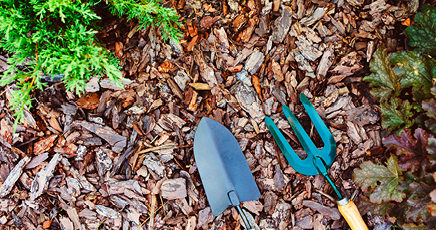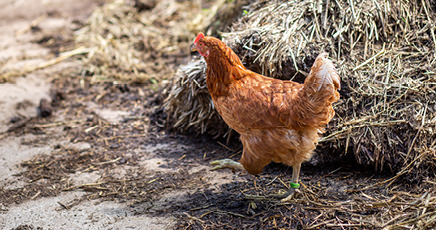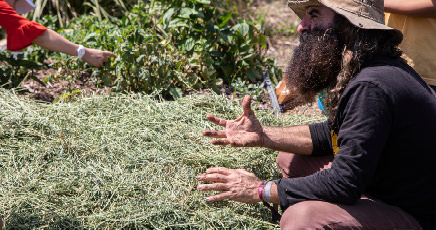LEARNING ACTIVITY
STORY
Beth and her Junior Landcare group started to discuss their plans for their food garden. There were so many ideas being shared on what types of garden would be best at growing the plants they wanted. One of her friends Eliza suggested that their group should think about a no dig garden bed, this was a garden bed she had established with her parents in their backyard. Eliza remembers her mum saying that these are easy to build and can be built over existing beds or on hard ground. The group agreed that this is something they should look into.

No dig garden beds are easy to build and can be built over existing beds or hard stony ground. They create a living nutrient rich soil for food gardens. Use this learning activity to get hands on and help establish a garden bed quickly and efficiently.
This learning activity is part of a sequence of 5 individual learning activities focused on creating a food garden. The order of these learning activities are: vision, site assessment, installing a no dig garden bed, planting and harvesting.
For children to:
• understand the steps involved in creating a food garden
• enjoy being active and productive outdoors and build their social and teamwork skills
• learn how to create a living garden soil organically by mixing carbon rich (brown materials) and nitrogen rich (green materials) ingredients.
When making a no dig garden in spring and summer, run as a morning activity to avoid heat stress for people and plants.
Introduction
Being involved in making a no dig garden is a great team building activity, it helps to establish plants very quickly without having to do heavy work of digging out a garden bed. As there is minimal disturbance of the soil layers in establishing this garden bed, it does not disturb existing soil life.
This activity will require adult supervision and some ground work to prepare and move materials. Adequate preparation of materials beforehand is important and safety instructions are essential. Having several helpers to contribute and fill in when others need a break will help this be an effective and efficient activity.
The time allocation for this activity is based on using a small garden bed space of about 2 metres by 1 metre. Larger areas will require more time, materials and assistance.
It would be ideal to have equal amounts of green and brown materials to layer in the garden bed.
Checklist
Instructions
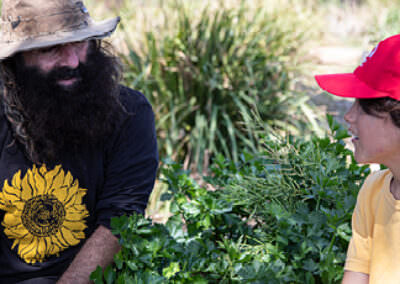
Step 1
Discuss the materials that you will need for your no dig garden bed. Ask the children what they think they will need to create a living garden soil. Discuss the benefits of carbon rich (brown) materials and nitrogen rich (green) materials.
Being ready with all your materials at the garden bed site location will save time and achieve the best results.
- Go through your checklist to ensure you have all the materials you need.
- As this is a step by step layering process, make sure you run through the plan with the children and outline the safety steps involved.
- Each layer will need to be watered in as this will settle the contents and enable best conditions for growth.
Have your garden border in place if you are making a raised bed. This can be untreated timber, bricks or straw bales.
No dig garden beds can be made without edging, however a path around the bed will help reduce weed build up.
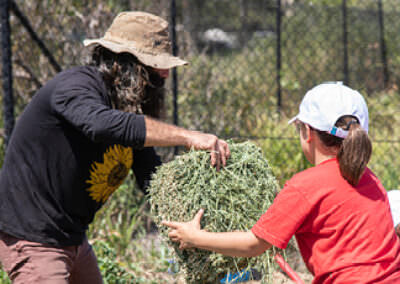
Step 2
If placing the garden bed on a non-porous surface like concrete, put a layer of blue metal gravel as the base. This will not be needed on a porous base.
Cover the garden bed base with a layer of wet soaked cardboard, to act as a thick weed mat. Water this layer.
Place a thin layer of other green materials over your weed mat. Then place loosely thick layers of the straw mulch. This makes up a bulky layer of material. Water this layer.
Put a layer of animal manure ensuring to sprinkle this on the straw mulch to help break it down. Water this layer.
Place another layer of other green materials on top of the animal manure. Then add another layer of the other brown materials. Water this layer.
Keep alternating between the other brown and green materials. Layering should stop about 30cms from the top to allow for the planting layer. Water this layer.
The top layer should be the vegetable garden soil mix or compost mixed with garden soil. Water this layer.

Step 3
Now that the no dig garden bed has been built, it won’t be long until seedlings can be planted. It can be good to wait a week or so before planting to allow the new garden bed to settle.
In the meantime, clean up after your work by packing away materials and thoroughly washing hands.
Ensure your no dig garden bed is looked after appropriately. Establish a regular watering roster. Be mindful of water restrictions in your local area.
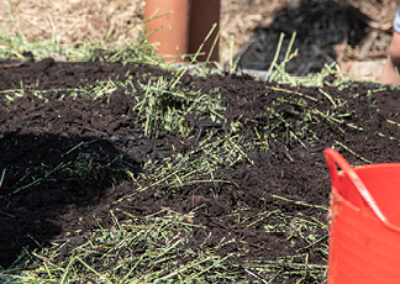
Step 4
Using the activity sheet, discuss what kind of layers were used to create your no dig garden bed.
Is straw mulch carbon rich or nitrogen rich? Is animal manure carbon rich or nitrogen rich?
Discuss whether you used more green or brown layers. What benefits do these materials bring? What do you expect to happen over time?
Extension Activity
What do you think are the advantages of creating a no dig garden? How is this approach different to digging up the ground to create a food garden?
Besides using cardboard as a weed barrier, what are other ways or resources you could use that you could control weeds when building a garden?
Curriculum and Framework Links
SCIENCE
Year 2: ACSSU030, ACSHE035
Year 3: ACSSU044, ACSIS054
Year 4: ACSHE062, ACSIS064
Year 5: ACSHE083
Year 6: ACSSU094, ACSHE100
Year 7: ACSHE120
Year 8: ACSHE135
HUMANITIES AND SOCIAL SCIENCES
Year 2 : ACHASSI042
Year 3: ACHASSI052, ACHASSI059, ACHASSI060
Year 4: ACHASSI080, ACHASSK088, ACHASSK090
Year 5: ACHASSI102, ACHASSK120
Year 6: ACHASSI122, ACHASSI130
DESIGN AND TECHNOLOGIES
Year 2: ACTDEK003
Year 3/4: ACTDEP017
Year 5/6: ACTDEP019
Year 7/8 ACTDEK032
HEALTH AND PHYSICAL EDUCATION
Year 2: ACPPS018, ACPPS022, ACPPS023
Year 3/4: ACPPS036, ACPPS040, ACPPS041
Year 5/6: ACPPS054, ACPPS059
Year 7/8: ACPPS073, ACPPS078
ETHICAL UNDERSTANDING
Exploring values, rights and responsibilities.
PERSONAL AND SOCIAL CAPABILITY
Social awareness
CROSS CURRICULUM PRIORITY
Sustainability
MY TIME, OUR PLACE: FRAMEWORK FOR SCHOOL AGE CARE
Outcome 2 and 4
Reference List
PRINTABLE RESOURCES
This mastering no-dig gardens fact sheet from Sustainable Gardening Australia provides more insight into establishing a no dig garden.
WATCH
Watch How to build a no-dig garden from ABC Gardening for inspiration and steps. 6.07 minutes.
We value your feedback
When you have finished this learning activity, please tell us what you think with our survey.
Your feedback will help Landcare Australia improve the activities in the Junior Landcare Learning Centre.
Why not try one of our other Junior Landcare learning activities?
Love Letters to the Land
Biodiversity|First Nations Perspectives|Food Production|Waste Management
Creating a food garden: vision
Food Production
Creating a food garden: planting
Food Production
Creating a food garden: harvesting
Food Production
